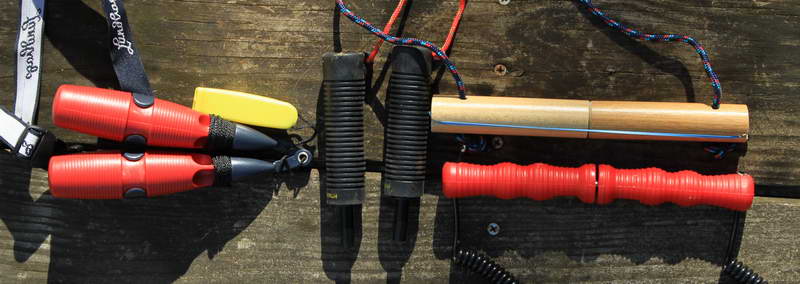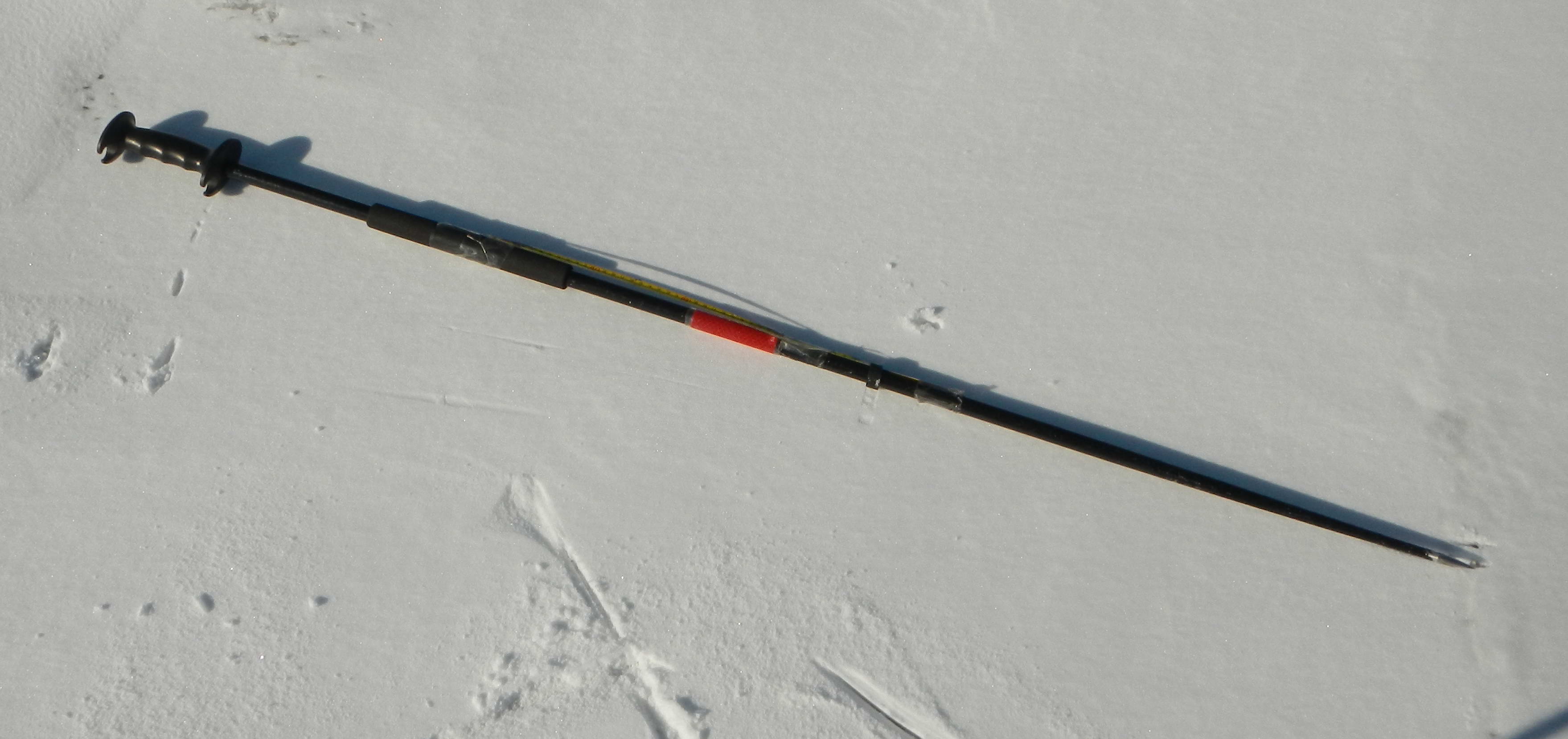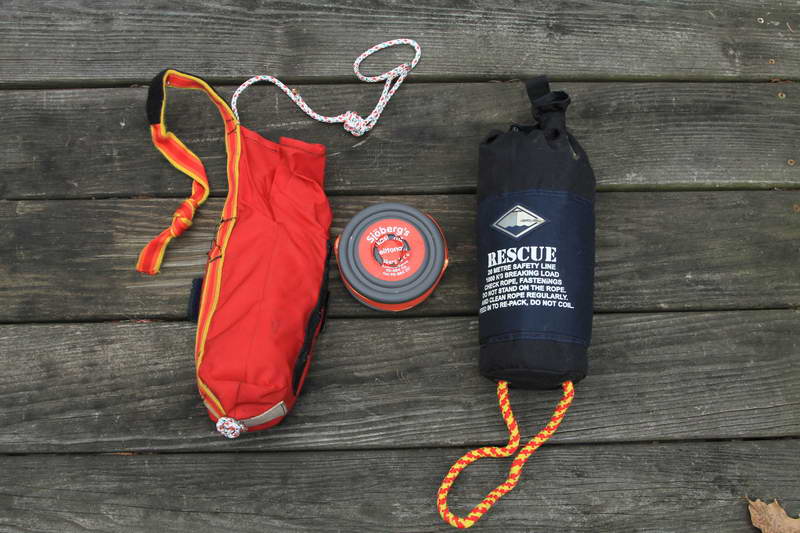Beyond Ice Claws: Ways to Reduce Risk
Equipment

- Make sure everyone in your group has ice claws. And maybe a few more to give to people you meet on the ice.
- Carry ice testing tools. They allow you to assess the ice without doing it with your body weight (skating/fishing) or with you and your vehicle. There are lots of types of tools.
 An ice saw and three wooden ice testing poles (the longest is 8 feet)
An ice saw and three wooden ice testing poles (the longest is 8 feet)
 Swedish Skating Pole: Light and effective.
Swedish Skating Pole: Light and effective.
- Bring throw ropes (obviously you should have more than one in your group).
 Different styles of throw bags with a reel type in the middle.
Different styles of throw bags with a reel type in the middle.
 Jeff Brown's throw rope, axe and screw. This set-up is a bit big to carry when sailing but it can be picked up quickly in a boat and brought to the scene of an accident quickly. Phot by Jeff.
Jeff Brown's throw rope, axe and screw. This set-up is a bit big to carry when sailing but it can be picked up quickly in a boat and brought to the scene of an accident quickly. Phot by Jeff.
Another way to carry a throw rope on an iceboat is to use a small diameter line and slip knot brade it into a fatter line that is used as the main sheet. If needed is removed from the boat, and the end not is removed alowing the slip knot unravels into a 50 knot line (check with a DN sailor for details).
- Wear some sort of traction on your feet. Carry something with you when skating in case you have to walk. I like Icebug shoes. Their carbide studs have decent grip on ice, are only moderately hard on wood floors and, most important, they have sufficient grip on hard smooth surfaces. Some hard steel based traction system feel like bannana peels on hard surfaces, especially once the cleats wear a little.
- Bring a cell phone (in a plastic bag). A GPS , compass and a map are a good idea as well. Lithium batteries for your GPS (and camera) do much better in the cold than alkaline or NiMH.
- If you are doing anything other than walking with foot traction, wear a helmet. It is common for skaters and walkers to have their feet slip out from under them, whacking the back of their head in the process. Tripping at speed (common with skaters and standup sailors) can also result in hard hits to the head (and elbows, sholders, hips, knees...)
- Flotation: Ice rescue experts recommend wearing a life jacket or float coat (There is a difference of opinion about weating floatation if you are inside a vehicle). If you can't get back on the ice they significantly increase your survival time to give rescuers more time to get to you. Inflatable life jackets are compact hand have a lot of flotation. In Europe, it is standard practice bring a water proof bag full of clothes in a pack which provides flotation as well.
- Automatic inflatable lifejackets are not recommended, especially on ice that is weak from thawing.
- As is the case with downhill skiing, goggles are better than more fashionable sunglasses for all but warm, calm days.
Clothing-Prepare for getting wet
The time honored method used in Europe is to bring a change of clothes in a waterproof bag. You need to add a leg loop (or two) to your pack to hold it down when you are in the water. The pack provides flotation and dry/warm clothes
The best bet is a breathable dry suit. They are expensive compared to Jeans and a wind breaker but they will seem like a great investment when you fall in. People who should seriously consider a dry suit include
- wild ice skaters (especially those of us with bad habits like skating alone).
- ice checkers of any type: being first on the ice is inherently on the dicey side.
- long distance sailors
- anyone who has a tendency to push things with dodgy ice
- people over 60 who, in general, have a significantly greater risk of a hypothermia induced heart arrhythmia that is sometimes fatal.
- A cheaper approach is a wet suit. I have used shorty and farmer john versions. They are not as effective as a dry suit but they are a big improvment over nothing.
There are a number of flotation suits available for snowmobiling. In addition to flotation they provide some protection from hypothermia.
Other Suggestions and guidelines:
- Ask others who have been using the same ice about problems. Many locals know a lot about the ice they have been on for years. Most of them have an interesting story or two.
- Test the ice yourself.
- Think about past and future weather and what is likely to have happend since you were last on the ice and what is likely to happen while you are out there.
- Read the cautionary tales for some perspective for what happens in the real world.
- Practice ice rescue. Be prepared for the inevitable time when things to go wrong.
- Always be ready to find something else to do if the ice or conditions are too dodgy for your taste. Don't go out just because you are there or because your fiends want to go or because a there are others already out there. Make your own decision.
- Be wary of thinking you know more than you do. Even the most experienced ice travelers get wet or scare themselves occasionally.
- Bring a buddy, preferably two or more. Being on the ice alone leaves everything in your hands.
- Stay in a line and at some distance from each other to minimize the risk that everyone falls in at once. Have a point person who is skilled at reading ice and leave even more room between the point person and the second person in the line. If the ice is on the weak side is a good idea to not walk on exactly the same track of the person in front of you to avoid fatigueing the ice.
- Plan to be off the ice well before dark and take a light in case you get back later than planned.
- Know the shore, islands etc well enough to know where you are. If you do not have a good mental image as you leave shore it can be hard to find where you started from. It rarely looks the same from way out there.
